Contents
dandasana
„staff pose“
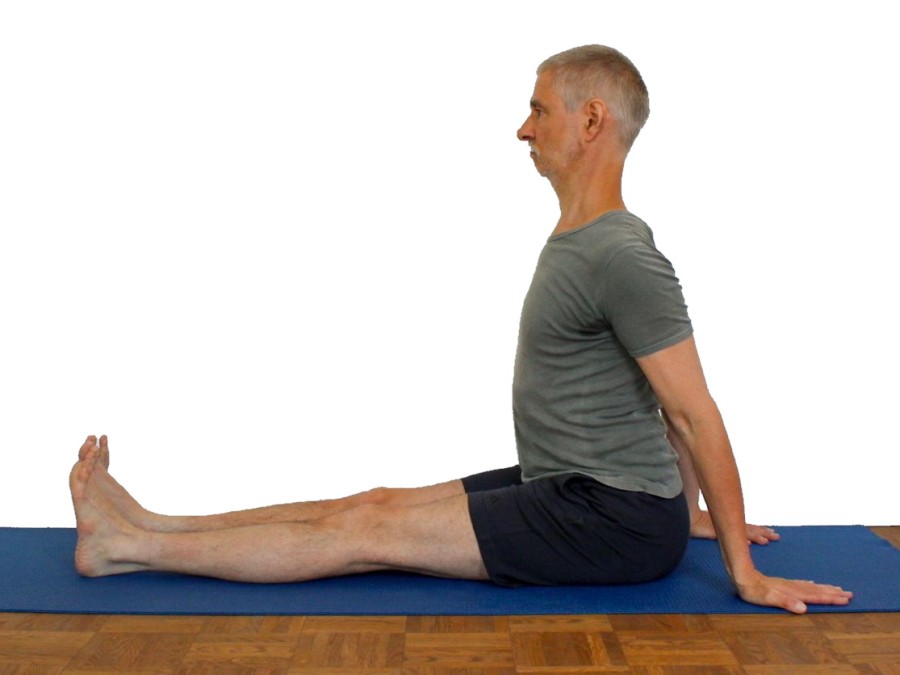
Feedback: We’d love to hear what you think about this description, give us feedback at:
postmeister@yogabook.org
Last modified: 30.12.2018
Name: dandasana
Trivial name: stick pose
Level: A
- classification
- contraindications
- effects
- preparation
- follow-up
- derived asanas
- similar asanas
- diagnostics
- instructions
- details
- variants
classification
classical: sitting pose
contraindications
In the case of disc hernias (herniated and bulging discs) in the lumbar spine, this pose can cause the known symptoms, if the flexibility of the hip extensors (mainly the hamstrings) is so restricted, that the area of the lumbar spine cannot be at least straightened (stretched), or even better physiologically lordotic.
effects
- (602) strengthening the erector spinae
- (721) stretching the hamstrings
preparations
A cardinal prerequisite is the flexibility of the hamstrings, because otherwise the pelvis tilts backwards; in order for this to improve, practise:
- uttanasana as a generally effective and efficient stretching of the hamstrings in preparation for the flexion in the hip joints
- prasarita padottanasana very similar to uttanasana
- parsvottanasana as a generally very effective and efficient stretching of the hamstrings
- parivrtta trikonasana as a very effective and efficient stretching of the hamstrings
- parivrtta ardha chandrasana as a very effective and efficient stretching of the hamstrings
- downface dog as also good preparation for the hamstrings, when the basin is tilted forcefully
- hip opener 5 as a very effective stretch that goes beyond uttanasana of the hamstrings
If, in addition to the hamstrings, the other extensors of the hip joint, in particular the gluteus maximus, pull the pelvis backwards, these should also be stretched beforehand:
- half lotus forward bend
- hip opener at the edge of the mat
- hip opener 3
- parivrtta trikonasana
- parivrtta ardha chandrasana
Active preparations are suitable for preparing for the requirement to stretch the back:
- desk-variant of uttanasana
- rectangular uttanasana
- warrior 3 pose
- backwards against the wall-variant of warrior 3 pose
- upface dog
- utkatasana
- upavista konasana with a block
and passive preparations:
and all backbends.
For the „urdhva hastasana“ variation, perform preliminary exercises for frontal abduction in the shoulder joints:
- downface dog, esp. variant „wide“ as general stretching for the shoulder
- back stretching, esp. variant „elevated“ as general stretching for the shoulder
- rectangular handstand as a related posture, which generally differs only in the coordinate system in which it is performed
- handstand
- elbowstand
- rectangular elbowstand
- dog elbow pose
- hyperbela as one of the most effective and efficient stretches in the direction of frontal abduction without external rotation of the arms
- shoulder opener at the chair as one of the most effective and efficient stretches of the shoulder in the direction of frontal abduction with external rotation of the arms
Since it is not easy not to use the rectus femoris for hip flexion to straighten the pelvis and it has a high tendency to cramp because it works close to the maximum concentric contraction and thus in a very short sarcomere length, prepare it with:
- ardha supta krouncasana
- supta krouncasana
- supta virasana
- quadriceps stretching 1 at the wall
- quadriceps stretching 2 at the wall
follow-up
The same things that can be practiced to reduce the tendency to cramp in the rectus femoris before the pose are also suitable for alleviating a tendency to cramp that has already occurred:
- ardha supta krouncasana
- supta krouncasana
- supta virasana
- quadriceps stretching 1 at the wall
- quadriceps stretching 2 at the wall
Derived asanas:
Similar asanas:
Diagnostics (no.)
(650) Kyphosis and lordosis of the spine:
The deviations from the physiological double-S shape of the human spine are only partially visible in this posture. There should be a certain degree of lordosis (convex spine from the front) in the lumbar and cervical spine and a certain degree of kyphosis (convex spine from the back) in the thoracic spine. This geometry is distorted by the mobility restrictions of the hamstrings, which are all too common and can tilt the pelvis backwards and reverse the lumbar lordosis. See the FAQ.
(611) uneven shoulder height/scoliosis of the spine
The lateral deviations of the spine from the sagittal plane known as scolioses are also quite visible in this pose, especially as the pelvis rests on the ischial tuberosities, i.e. is horizontal. See the FAQ
In this pose, the strength endurance of the back extensor (erector spinae) becomes apparent. In addition to good mobility, the body’s internal resistance in the pose guarantees the need to stretch the back continuously and powerfully with the back muscles. Any tension, whether caused by pose, professional or other demands, scoliosis, hyperkyphosis of the thoracic spine or misaligned vertebrae, should become apparent here.
variants:
Instructions
- Sit upright with your legs stretched out and closed.
- Pull the buttocks backwards and outwards and use the strength of the hip flexors to straighten the pelvis vertically. Stretch your upper body vertically upwards.
- Place your hands fully on the floor to the side of your pelvis with your fingers pointing forwards. Pull the shoulder blades inwards and downwards (retraction and depression). Depending on your body proportions, bend your elbows backwards.
- Straighten your legs so that your knees are extended and as much of the back of your thighs as possible is on the floor. Stretch the heels away from the pelvis.
- Work your back muscles to stretch your upper body and keep it straight.
- Stretch the crown of your head towards the ceiling.
details
- For less flexible beginners, it may not be possible to straighten the pelvis into a vertical position. Consistent practice of forward bends, especially uttanasana, will help with time. At least uttanasana should also be practised as direct preparation before dandasana. The pelvis should be straightened as much as possible using the hip flexors in the pelvis (iliopsoas) and not the rectus femoris in the thigh, as this could lead to cramping of the rectus femoris because it is close to its maximum concentric contraction due to the stretched knees and bent hips and therefore close to minimum sarcomere length, i.e. close to active and passive insufficiency and therefore has little strength to erect the pelvis on the one hand and would cramp relatively quickly on the other.
- Other aids for erecting the pelvis include working the arms, which in co-operation with the back muscles can bring about a certain improvement in erecting the pelvis, as well as sitting on an elevation such as a blanket or one or more multiple folded mats. The support is used correctly when you are sitting more on the front edge of the ischial tuberosities, i.e. generally when you feel that you are almost slipping forwards from the support.
- As always, the hands are pressed as fully as possible onto the floor and exert a certain amount of force, in addition to pushing the hands backwards against the friction of the mat, which tends to support straightening the upper body. It is sufficient to keep the fingers slightly open, maximum spreading is not necessary. It is important to bend the elbow joints enough to keep the shoulder blades down. The question of how far the arms need to bend or whether the hands can even reach the floor and be fully supported is a question of body proportions. Sitting giants may not be able to press their hands to the floor but need support such as a block, sitting dwarves need to bend their arms quite far, which is unproblematic. If the hands are pushed backwards forcefully (of course they remain in place), this could lead to a tendency for the middle triceps (caput longum) in the back of the upper arm to cramp for a similar reason to how the (also biarticular) rectus femoris in the thigh can cramp, i.e, that the middle triceps is also in a very short sarcomere length due to the extension in the elbow joint and the zwri frontal abduction or slight retroversion of the arms and is therefore close to its maximum concentric contraction and should exert force there in the direction of further retroversion of the arm. Of course, the cramp must be avoided right from the start. Increased flexion of the elbow joint can often reduce the tendency to cramp.
- The heels are stretched away from the pelvis, but not so much that the muscles in front of the lower leg (dorsiflexors) would start to cramp as a result. In particular, the toes are slightly spread and above all stretched and not in dorsiflexion, which would promote a tendency to cramp in the ventral lower leg muscles (the ankle dorsiflexors and those of the toes).
- Depending on the individual anatomy and the development of the calf muscles, the heels may lift off the ground when the knees are extended. This can be allowed in the sense of correct extension in the knee joint, or you can leave the heels on the floor and possibly forego the last degree of extension in the knee joint, but have less effort to prevent the feet from falling into plantar flexion thanks to the friction of the heels on the floor. Of course, the ability to extend the thoracic spine also plays a secondary role.
- Keep the crown of the head stretched upwards. Maintain the physiological lordosis of the cervical spine and avoid moving the head forwards or backwards in relation to standard anatomical pose.
- The ease – or difficulty – of stretching the upper body depends largely on the ability to straighten the pelvis and therefore the flexibility of the hamstrings. For less mobile beginners, this pose may therefore be primarily an exercise for the strength endurance of the erector spinae and this may be the limiting factor.
- If there is cramp-like stress in the dorsal wrist/forearm, which can be the case with sitting giants in particular, the variant with inverted hands can be practised instead.
Variants
urdhva hastasana (arms up)
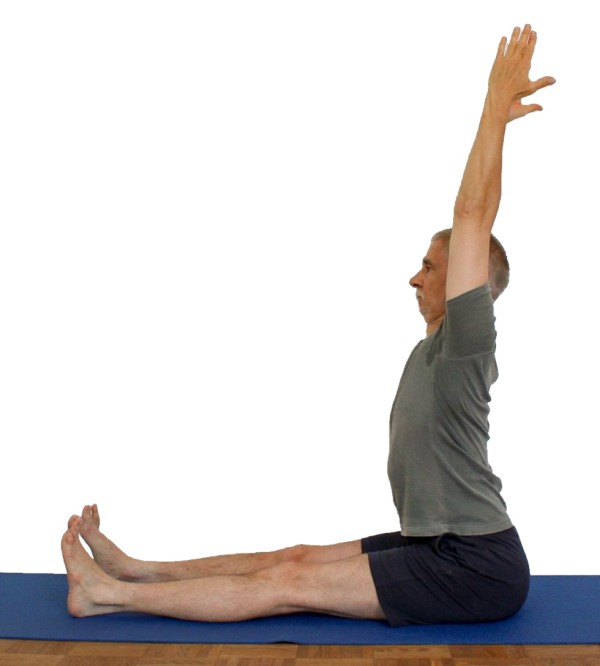
Instructions
- Take the pose as described above.
- Stretch your parallel and straight arms with your shoulder blades upwards (shoulder blades in elevation), turn the arms out to the maximum and move them backwards as far as possible.
details
- This variation is a very interesting way for many people who are inflexible in the shoulders and especially in the hamstrings to familiarise themselves with their internal muscluar resistances and to strengthen the back muscles against these resistance.
Similar to upavista konasana with a block, a noticeable tendency to cramp in the rectus femoris can also occur here if the flexibility of the hamstrings is significantly restricted, making it necessary to sit on a small elevation. On the other hand, if there is hardly any need for intensive work with the autochthonous back muscles, the feet can be placed on a block. - In view of the three dimensions of movement in the shoulder joint, attempts to raise the arms to the maximum will be met with evasion in the other two dimensions, namely internal rotation and outward movement; this would also apply by analogy to any other dimension of movement.
- As long as the arms have not yet reached the vertical, they create moments that bend the thoracic spine – completely against the requirements of the pose. This is part of the exciting work that people with limited flexibility have to do in this pose. The other part results from the fact that the pelvis often does not become approximately upright, let alone that it might be able to tilt forwards, but tends to tilt backwards. This results in a curvature of the back, which has to be worked against in this pose. For some people, the trunk is therefore curved from its upper end (shoulder joints) and from it lower end (hip joints) and they have to work with all their strength (and endurance) to straighten their back, although in many cases it is still a long way from being straight. In this respect, the pose is similar to halasana, except that the angle of flexion in the hip joints is significantly greater there and on the cranial side the flexion moments in the thoracic spine are not generated by the arms but by the thoracic spine itself and are also significantly greater.
- What has been said about the tendency to cramp in the trapezii in similar poss such as urdhva hastasana applies analogously here, perhaps even more so than in urdhva hastasana, as it is often not yet possible to bring the upper thoracic spine into a vertical and extended position.
- In any case, it is a good idea to pull the buttocks backwards and outwards as far as possible. If there is still a tendency to cramp in the rectus femoris, you can work with a support on which you sit with the „rear edge“ of the buttocks so that you almost feel as if you are slipping off the support. Any support of this kind will not only reduce the tendency to cramp but also make it easier to stretch the back. So use the support as sparingly as possible so as not to deprive yourself of the opportunity to work intensively while you are still in this state. Maximise the use of the hip flexors in the pelvis (iliopsoas) in an attempt to erect the pelvis.
- This pose can be understood and performed as an attempt to perform a backbend in the spine during a forward bend in the hip joints. This puts it in line with the corresponding variations of uttanasana (desk) and prasarita padottanasana. Cramps in the autochthonous back muscles during intensive backbends are rare, but not completely ruled out. As always, avoid cramps. If the back muscles feel too tight or tense after the pose, perform karnapidasana or parsva uttanasana. If this also affects the side of the lower back, add parsva upavista konasana.
- The most important directions of movement: the sternum moves mainly upwards and slightly forwards, the shoulder area with the entire arms backwards, the hip bones (ASIS) and the abdominal region forwards, the ischial tuberosities backwards, the shoulder blades upwards.
urdhva hastasana with a block
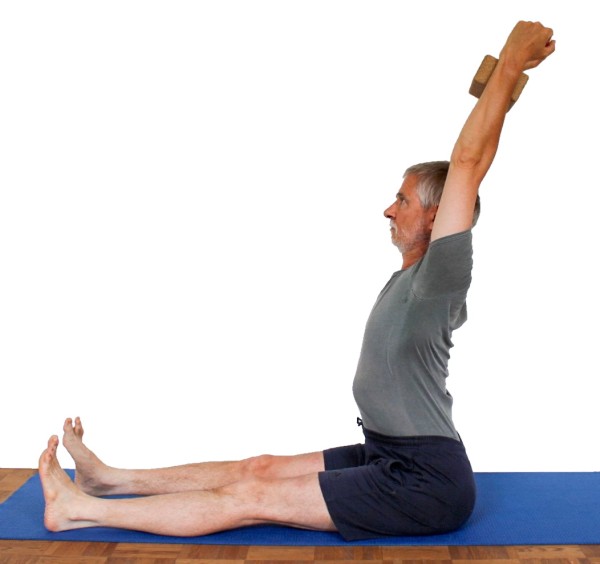
Instructions
- Take the variant „arms up (urdhva hastasana)“ as described above, but hold a block between the forearms, analogous to upavista konasana with block.
- Move your arms with the block as far back and up as possible, maximising the elevation of your shoulder blades.
Details
- Everything said in the „arms up“ variant still applies here, some of it even more so, but the block should make you more aware of the movement of the arms. It also creates the need to push the arms towards each other and thus against the block so that the block has sufficient friction due to the pressure and cannot fall, which creates additional exciting work.
- This variation is the equivalent of the „block“ variation of upavista konasana, most of what is said there applies analogously here.
Hands to the back

Avoidance of the tendency to cramp in the forearm/missing sensation in the wrist.
Instructions
- Take the pose as described above, but place your hands so that your fingers are pointing backwards and, if necessary, place your wrists just behind your pelvis instead of next to it.
details
- The purpose of this variation in contrast to the normal version is to remedy the tendency to cramp in the dorsal sides of the forearms or the wrists that may arise, especially in the case of sitting dwarves (relatively long arms compared to the upper body) in combination with restricted flexibility in the forearms. Sitting giants may have to place their hands on blocks.
pull the block

Do and leave
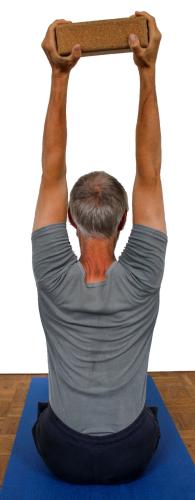
Straightening the back, strengthening the back muscles
Instructions
- Do dandasana as described above, holding a block between your hands overhead with your arms outstretched and pulling on it from the side with both hands.
Details
- This variation is a modification of the variant with the block and an analogy to the corresponding variation of upavista konasana, which on the one hand simplifies the work of the arms and shoulder muscles because it is no longer necessary to press against the block to prevent it from slipping or falling. On the other hand, the elimination of this movement significantly reduces the tendency to cramp, which is very beneficial for those who are prone to cramps in the trapezius. However, the improved stretching of the back associated with working the arms is essentially retained.
(S)
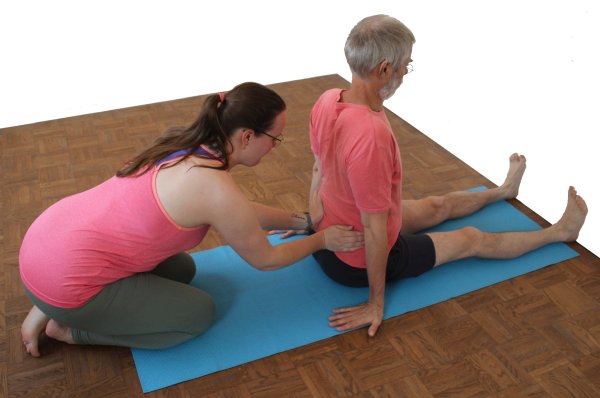
Instructions
- Take the pose as described above.
- The supporter sits behind the performer and presses with both hands, or better with both feet, on the upper sacrum/lower lumbar spine to promote flexion in the hip joints.
Details
- One of the greatest difficulties in dandasana is usually erecting the pelvis. There are often restrictions in the flexibility of the hamstrings that prevent this. External pressure can relieve and support the hip flexors of the performer and reduce or stop the tendency of the rectus femoris to cramp.
- As in all partner exercises, the forces used are slowly increased up to a point signalled by the performer and then slowly reduced again at the end of the support.
(S) urdhva hastasana

Instructions
- Take the urdhva hastasana variation as described above.
- The supporter kneels behind the performer and slowly and carefully pulls both upper arms evenly backwards while applying the same amount of counter-pressure with the head between the shoulder blades.
details
- As in poses such as parivrtta trikonasana and comparable variations performed as a partner exercise, the forces exerted in the two opposite directions must also correspond here, in particular the pressure with the head must be at least as strong as the pull on the arms. The grip of the hands goes to the upper arms, which are held parallel and turned out at the same time, the pressure of the head should be sufficiently comfortable between the shoulder blades, at least up to normally tolerable forces. The supporter must ensure that the head is positioned reasonably perpendicular to the performer’s back and with a straight cervical spine so that the load can flow largely straight through the spine and there is no damaging effect on the neck.
- As in all partner exercises, the forces used are slowly increased up to a point signalled by the performer and then slowly reduced again at the end of the support.
- Depending on the size ratio between the performer and the supporter, it may be advisable to apply pressure with the knee instead of the head. If the pressure of the knee on the spinous processes is felt to be too hard, a softness mediator should be used in between.
- A cross grip is ideal for the arms, in which the supporter grips the left arm of the performer from the inside with the right hand and vice versa. This leads to several desirable effects at the same time: on the one hand, the arms are pulled towards each other and towards the supporter and, on the other hand, the pull on the inside arms creates a desirable external rotation moment in the shoulder joints.
(P) urdhva hastasana with head
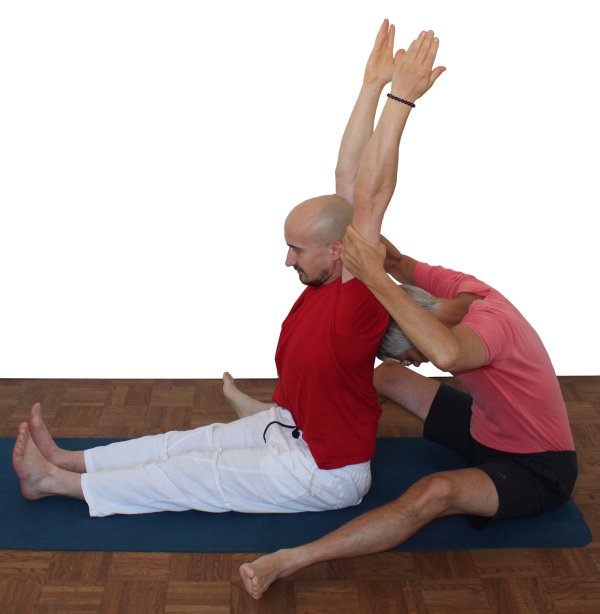
Instructions
- Take the urdhva hastasana variation as described above.
- The supporter kneels behind the performer and slowly and carefully pulls both upper arms evenly backwards while applying the same amount of counter-pressure with the head between the shoulder blades.
details
- As in postures such as parivrtta trikonasana and comparable variations performed as a partner exercise, the forces exerted in the two opposite directions must also correspond here, in particular the pressure with the head must be at least as strong as the pull on the arms. The grip of the hands goes to the upper arms, which are held parallel and turned out at the same time, the pressure of the head should be sufficiently comfortable between the shoulder blades, at least up to normally tolerable forces. The supporter must ensure that the head is positioned reasonably perpendicular to the performer’s back and with a straight cervical spine so that the load can flow largely straight through the spine and there is no damaging effect on the neck.
- As in all partner exercises, the forces used are slowly increased up to a point signalled by the performer and then slowly reduced again at the end of the support.
- Depending on the size ratio between the performer and the supporter, it may be advisable to apply pressure with the knee instead of the head. If the pressure of the knee on the spinous processes is felt to be too hard, a softness mediator should be used in between.
- A cross grip is ideal for the arms, in which the supporter grips the left arm of the performer from the inside with the right hand and vice versa. This leads to several desirable effects at the same time: on the one hand, the arms are pulled towards each other and towards the supporter and, on the other hand, the pull on the inside arms creates a desirable exorotation moment in the shoulder joints.
